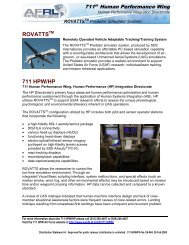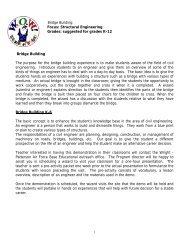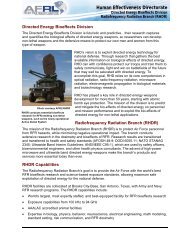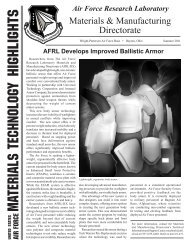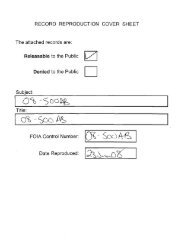AFMETCAL Newsletter - Wright-Patterson Air Force Base
AFMETCAL Newsletter - Wright-Patterson Air Force Base
AFMETCAL Newsletter - Wright-Patterson Air Force Base
You also want an ePaper? Increase the reach of your titles
YUMPU automatically turns print PDFs into web optimized ePapers that Google loves.
Page 22<strong>AFMETCAL</strong> NEWSLETTERApril 2011Volume 31, Issue No. 3From The Bench (continued)(Continued from page 21)Doing Phase With The 33220A (continued)The old 3325A had a Phase Zero function, allowingany phase position to become the new zero degreereference point. The 33220A doesn’t have that.But the easy way to verify the 33220As phase accuracybefore you use it for any traceable phase offset,since I do not believe it is a calibrated function,would be to use a 53131A or 53132A Counter inPhase mode, set the 33220A to zero degrees and runit to Counter CHA , and your second generator withlocked time-base, run it to Counter CHB, and thenwhatever your 53131A counter reads, enter the samenumber into its OFFSET Function, but with the oppositepolarity. Phase measurements come out almostentirely nominal, that is, when measuringphase between two square-waves. Using squarewaves minimizes the trigger slew error characteristicof measuring phase between sine or triangle waves(slew error being the slight differences in time whenPictured above:Mr. Scott WeissAndersen PMELtriggering along a slant or a slope if the vertical amplitude of the trigger should vary even by slight amounts,but if the waveform has a perfectly vertical edge, such as with a square wave, then no slew error can theoreticallyexist as differences in the vertical trigger result in no horizontal time displacement).You can also verify phase accuracy using one of those new generation high accuracy digital oscilloscopes,such as the LeCroy LC584 or the Tektronix TDS5054. You might be able to do the job with cursors andzoom functions, but it’s probably easier to just use DELAY – set your zero degree reference, where your twogenerators coincide, using 0.0 delay and then check your cardinal phase points by loading in target DELAYs,and then adding or subtracting 90, 180 and 270 degrees to your 33220A degree setting. For instance, if youare using a phase signal of 100KHz, well, that is a period of 10uS. So your 90, 180, and 270 degree delay targetswould be 2.5, 5.0 and 7.5uS’s respectively. If you take your Period of 10uS and divide it by 360, thisgives you your time per degree, which in this case is 27.7777nS per degree. Again, my 33220A was hittingthe delay targets right on the line, and what jitter I was getting was probably from the 3325A which I was usingas the second reference generator (the jitter we see on delayed signals is classic Phase Noise, and if youcan actually watch it squirm back and forth, then it is probably phase noise in the 1Hz to 100Hz offset rangewhere phase noise tends to be highest).If you are unsure how to calculate tolerances of your digitizing scope or are unsure of its accuracy, simplytransfer the accuracy of a known accuracy waveform, such as measuring the period of your 100KHz signal -whether you use cursors or set in a delay of 10 uS, you will find that these scopes return readings that are virtuallynominal.(Continued on page 23)




